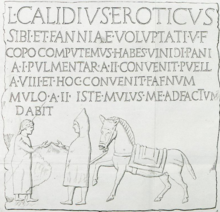Gravestone of Lucius Calidius Eroticus

The grave stone of Lucius Calidius Eroticus is a well originating from the first half of the 1st century grave stone for the Roman freedman Lucius Calidius Eroticus and his wife Fannia Voluptas.
Research history
It was found in or near Isernia , ancient Aesernia , or in the neighboring municipality of Macchia d'Isernia at the latest in the 17th century . The stone monument changed hands several times, belonged to the collection of Francesco Maria Avellino in the middle of the 19th century and was acquired in 1901 for the collection of the Louvre in Paris . Plaster casts are in the Museo Civico di Baranello and in the Museo della Civiltà Romana in Rome , a bronze replica in the Pontificia fonderia di campane Marinelli in Agnone .
The tombstone was first published in 1848, by both Avellino and Raffaele Garrucci in his history of Isernias. However, Theodor Mommsen , who was there in 1846 to record the inscriptions from the Kingdom of Naples, had initially forgotten to include the inscription of the monument for the Corpus Inscriptionum Latinarum , as he later had to admit.
Description and inscription
The irregularly preserved tombstone has a maximum height of 95 cm, a width of 59 cm and a depth of 31 cm. It is bumped on all sides and shows in the lower part the 57.5 cm × 59 cm large image and inscription field with the relief of a man in a hooded cloak with a saddled mule and a second person. The inscription allows the man leading the mule to be interpreted as a hostel guest and the second person as a hostel host.
The unusual inscription (CIL IX 2689) reads:
"L (ucius) Calidius Eroticus / sibi et Fanniae Voluptati / v (ivus) f (ecit) / copo computemus habes vini / Ɔ (sextarium) I pane (m) / a (sse) I pulmentar (ium) a (ssibus) II convenit puell (am) / a (ssibus) VIII et hoc convenit faenum / mulo a (ssibus) II iste mulus me ad factum / dabit "
Accordingly, Lucius Calidius Eroticus had the tombstone set for himself and Fannia ("his lust" or - more likely as a name form - "for Fannia Voluptas") during his lifetime. This is followed by a funny dialogue with the operator of a hostel: “Landlord, let's settle the accounts!” - “You had a Sextarius wine and bread for an ace , food for two aces.” - “All right.” - “A girl, eight Aces. ”-“ Also okay. ”-“ Hay for the mule, two aces. ”-“ This mule will ruin me! ”
The inscription gives an indication of the costs incurred in an ancient inn, a mansio . The cost of the girl is an indication of prostitution in these inns. The attempt to explain the epitaph also includes the fact that Calidius and Fannia themselves ran such a restaurant, since the combination of the cognomen Eroticus and Voluptas can be understood as a programmatic allusion to a hostel establishment .
literature
- Serge Ducroux: Catalog analytique des inscriptions latines sur pierre conservées au Musée du Louvre . Paris 1975, p. 55, No. 166.
- Sylvia Diebner : Aesernia - Venafrum. Investigations into the Roman stone monuments of two country towns. Rome 1979, p. 174 f. Fig. 62 Cat.No.Is 62 plate 38.
- Pierre Flobert : A propos de l'inscription d'Isernia (CIL IX 2689). In: Mélanges de littérature et d'épigraphie latines, d'histoire ancienne et d'archéologie. Homage à la mémoire de Pierre Wuilleumier . Paris 1980, pp. 121-128.
- Marco Buonocore: Le iscrizioni di Aesernia (= Molise. Repertorio delle iscrizioni latine . Volume 5, 2). Palladino, Campobasso 2003, pp. 124–126 No. 89.
- Herbert Bannert : "Herr Wirt, the bill!" A gravestone from Aesernia (CIL IX 2689) and some comments on the interpretation of text and images. In: Franziska Beutler, Wolfgang Hameter (Hrsg.): “A very ordinary inscription ...” and the like for Ekkehard Weber's birthday - Festschrift for April 30, 2005 (= ancient historical-epigraphic studies. Volume 5). Austrian Society for Archeology, Vienna 2005, pp. 203–213.
- Elisa Terenziani: «L. Calidi Erotice, titulo manebis in aevum ». Storia incompiuta di una discussa epigrafe isernina [CIL IX, 2689]. In: Ager Veleias 3.09 (2008) ( digitized version ).
Web links
- Grave relief of Lucius Calidius Eroticus and Fannia Voluptas in the Arachne archaeological database
- Inscription and tombstone in the Heidelberg Epigraphic Database
Remarks
- ^ Francesco Maria Avellino in: Bullettino archeologico Napoletano. Year 6, 1847–1848, plate 4 ( digitized version ).
- ↑ Raffaele Garrucci: La storia di Isernia raccolta dagli antichi monumenti. Naples 1848, pp. 135-141 ( digitized version ).
- ↑ Theodor Mommsen (Ed.): Corpus Inscriptionum Latinarum Volume IX: Inscriptiones Calabriae, Apuliae, Samnii, Sabinorum, Piceni latinae . Berlin 1883, p. 251 No. 2689.
- ^ A b John R. Porter: Funeral Monument of L. Calidius Eroticus and Fannia Voluptas (CIL IX.2689) at academia.edu (2018), with picture.
- ↑ CIL IX, 02689